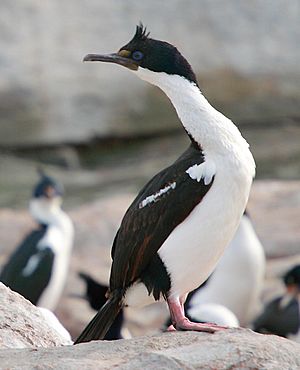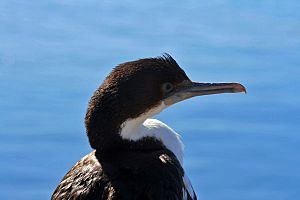Imperial shag facts for kids
Quick facts for kids Imperial shag |
|
|---|---|
 |
|
| Conservation status | |
| Scientific classification | |
| Genus: |
Leucocarbo
|
| Species: |
atriceps
|
| Synonyms | |
|
|
The imperial shag or imperial cormorant (Leucocarbo atriceps) is a cool black and white cormorant bird. It lives in southern South America, mostly near rocky coasts. You can also find them by big lakes inland.
Some scientists call this bird Leucocarbo atriceps, while others call it Phalacrocorax atriceps. It's also known as the blue-eyed shag because of the bright blue skin around its eyes! There are many types of blue-eyed shags, and the way scientists group them can be a bit tricky. What one scientist calls a different type, another might call a subspecies (a smaller group within a species).
Contents
Meet the Imperial Shag: What Does It Look Like?

The imperial shag is a medium-sized bird, about 70 to 79 centimeters (27 to 31 inches) long. It weighs between 1.8 and 3.5 kilograms (4 to 7.7 pounds). Male shags are usually bigger than females.
Most of its body is covered in shiny black feathers. But its belly and neck are bright white! Around its eyes, it has a special ring of bright blue skin. It also has an orange-yellow bump on its nose and pinkish legs and feet. When it's time to find a mate, it grows a cool black crest on its head. After the breeding season, this crest disappears, and its face colors become a bit duller. The shag has a bill with small saw-like edges, which helps it catch slippery fish.
Different types of imperial shags look very similar. The main differences are how much white they have on their cheeks, ear-coverings, and wings. Most shags have white cheeks. But some, like the ones from the Falkland Islands, have black cheeks.
Baby shags are all brownish. Young shags are brownish and white, not black and white like adults. They also don't have the bright orange-yellow nose bump or the blue eye-ring yet.
Life and Habits: How Do Imperial Shags Live?
Breeding and Raising Chicks
Imperial shags like to live in groups called colonies. They are also monogamous, meaning one male and one female stay together to raise their young. These colonies are usually small, but some can have hundreds of pairs! Shags often share their nesting spots with other seabirds, like rock shags, penguins, and albatrosses.
The female shag usually lays two or three eggs, but sometimes up to five. They build their nests from seaweed and grass, using mud and their own droppings to hold it all together. Both parents take turns sitting on the eggs to keep them warm. The eggs usually hatch in about five weeks. Sadly, many eggs and chicks are eaten by predators like skuas and sheathbills.
What Do Imperial Shags Eat?
Imperial shags are good hunters in the water. Their diet includes small fish that live on the seafloor, as well as crabs and shrimp, worms, snails, and small octopuses. They especially love to eat a type of fish called Argentine anchoita.
When they dive for food, they can go almost 25 meters (82 feet) deep! They usually hunt close to the shore. However, some groups will travel further out into the ocean to find good fishing spots.
Where Do Imperial Shags Live?
Imperial shags are found in the southern parts of South America. This includes the coasts of Chile and Argentina. You can also find them on islands like the Falkland Islands, Antarctic Peninsula, South Georgia and the South Sandwich Islands, Heard Island, Crozet Islands, Prince Edward Islands, and Macquarie Island.
Scientists sometimes group these birds differently. Some think they are all one species with different types (subspecies). Others think some of these groups are actually separate species. For example, some shags have white cheeks, while others have black cheeks. These differences help scientists figure out how they are related.
Are Imperial Shags in Danger?
Good news! The imperial shag is not considered a threatened bird. Organizations like BirdLife International and IUCN list it as "Least Concern." This means there are plenty of them around. Most types of imperial shags are quite common, with estimates of over 10,000 pairs for each group.
See also
 In Spanish: Cormorán imperial para niños
In Spanish: Cormorán imperial para niños



